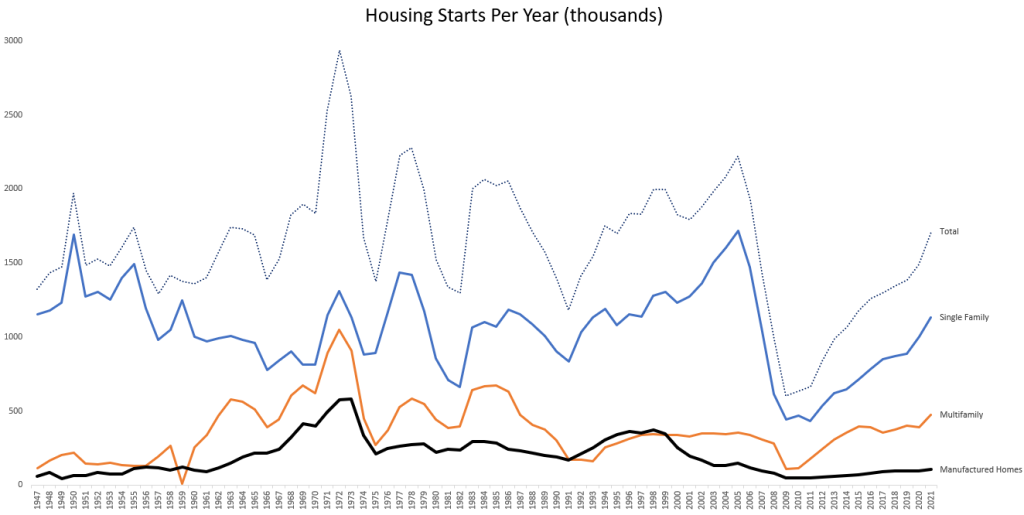
In 1973, 580,000 mobile homes (or manufactured home as they are now called) shipped in the United States. This represented about 50% of the number of single-family housing starts that year, and about 22% of total housing starts. So they represented a significant chunk of the overall housing supply.
But following the collapse of the US housing market in 1974, an interesting thing happened. Manufactured homes never managed to reclaim their position in the stack. See above chart. Brian Potter, author of Construction Physics, puts forward a number of possible explanations for this, over here.
Some have speculated that it was the result of new code changes that ended up increasing costs. Some have speculated that it was because of a new requirement to include a steel chassis on the bottom of every home, which also increased costs, but more importantly stigmatized manufactured homes. It made them seem transient, whereas previously they were installed on permanent foundations.
There are also some theories that manufactured home production was harder hit during the economic downturn given that they had more fixed plant costs (compared to site-built homes with their variable labor costs).
But Brian’s current working theory is that it comes down to capital flows. Manufactured homes tend to cater to lower-income buyers and so supply, as the argument goes, has largely depended on “lax lending” practices being made available to them.
I’m not so sure that this is the only reason though. For one thing, multi-family housing starts have followed a somewhat similar trajectory to manufactured homes. We’ve certainly seen an increase in supply over the last decade, but we’ve never gotten back to that early 1970’s peak.
And so I wonder: How much of this is actually just the result of the single-family home hegemony? This is arguably what the market has historically wanted (look at the split pre-1973 in the above chart), and so perhaps we simply refocused our attention there and worked to make this housing type as accessible as possible to the masses.
Chart via Brian Potter

What happened to multi-family dwellings in 1959?
LikeLike
Great question!
LikeLike
As I posted on his site, the subprime crisis hit MH before it hit SFH. Because MH is considered personal and not real property, lending on these homes (single homes on an owner’s lot do qualify for traditional lending) has always been more expensive than SFH. When the lenders collapsed in the early 2000s, any new demand had to be paid for by the park owners, few of whom were set up for that kind of capital requirement. You also had a new business line of renter occupied housing and homes that weren’t built or maintained (by residents or park staff) properly. Most park owners didn’t understand or like the new business line, and the park owned homes didn’t qualify as collateral on the land loans.
Because these are personal property and usually occupied by less wealthy people, they have a particularly weak political voice. Towns and cities that until very recently have made it all but impossible to open new parks did not want “that crowd” around. So capital and regulatory opposition dramatically affected the number of new homes.
Finally, Cavco and Berkshire-Hathaway control most of the home building industry, which also suppressed shipments.
LikeLike
Hey Brandon – maybe it was because of tornados! As Dr. Johnny Fever put it in WKRP in Cincinnati: “I think God must really hate mobile homes, because tornadoes always attack them first… they get very mobile.” 😉
LikeLike